
Ryan. Экспериментальные самолеты.
В 1955-1963 годах компания "Ryan" разработала ряд необычных экспериментальных самолетов.
<...>
Ryan XV-8A Fleep: два таких экспериментальных самолета с гибким крылом были построены "Ryan" для Армии США. По сути, машина представляла собой одноместный мотодельтаплан с крылом Рогалло. На открытой платформе находилось 12 швартовочных колец для груза, позволявших аппарату перевозить до 454 кг полезной нагрузки (включая пилота) с максимальной скоростью 105 км/ч. Простой в пилотировании аппарат был легок в разборке и сборке, а его транспортировка не вызывала затруднений.
<...>
- Описание
Фотографии
-
Aviation Historian 1 / D.Moore - Ryan and the triangular pterodactyls
Регистрационный номер: N140N Everett at the controls of what the Ryan press department described as “the craziest kite in the sky” during its flight test programme. The triangular object within the main control framework is the fuel tank. The front wheels were steerable and the rear wheels were fitted with brakes.
-
Aviation Historian 1 / D.Moore - Ryan and the triangular pterodactyls
The Flex-Wing in flight over Californian farmland during its test flight programme. Lou Everett explained, “our test bed at Ryan is not a prototype for a production aircraft. It is for research alone, hence all its cables and linkages are exposed. We can make all the necessary adjustments without having to open a lot of panels”.
-
Aviation Historian 1 / D.Moore - Ryan and the triangular pterodactyls
Everett takes the Flex-Wing into the air during one of its test flights at Brown Field in the summer of 1961. The aircraft was purely experimental, about which Everett was emphatic in press releases: “Don’t try and build one of these yourself. The design factors are very precise and even a small change can make a tremendous difference in safety”.
-
Aviation Historian 1 / D.Moore - Ryan and the triangular pterodactyls
Two XV-8A Fleeps, 63-13003 and 63-13004, were built for further research into the Rogallo wing, the first of which is seen here at the US Army Proving Ground at Yuma. Although the type’s trials were entirely successful, the concept was not adopted by the military.
-
Jane's All the World Aircraft 1964 / 01 - Aircraft
Ryan Fleep flexible-wing aerial utility vehicle
-
Aviation Historian 1 / D.Moore - Ryan and the triangular pterodactyls
Ryan Aeronautical test pilot Lou Everett explains the controls of the company’s Flex-Wing to US Navy personnel at Naval Auxiliary Air Station Brown Field, near San Diego, in 1961. Everett saw a great deal of potential in what he called the “Pterodactyl”, saying “we don’t yet realise all the possibilities of the brand new, yet millions-of-years-old, flexible wing”.
-
Air Enthusiast 2006-05 / D.Willis - V for Variety /Air forces/ (1)
XV-8 Fleep был оснащен двигателем Continental IO-360A мощностью 210 л. с. (157 кВт), установленным в хвостовой части и приводящим толкающий винт.
In January 1962 the Ryan Model 164 was 'flown' in NASA’s full-scale wind-tunnel at Langley, Virginia. It differed from the XV-8A delivered to the Army in several ways, the most notable being that the XV-8A had twin 'butterfly' fins. -
Aviation Historian 1 / D.Moore - Ryan and the triangular pterodactyls
NASA engineers are dwarfed by the cavernous throat of the agency’s full-scale windtunnel at Langley during trials of the Flex-Wing, following the completion of its initial flight research programme in 1961.
-
Aviation Historian 1 / D.Moore - Ryan and the triangular pterodactyls
The keel and leading edges of the Rogallo wing are put in place over the Dacron/Mylar fabric. Rogallo also intended for the concept to be used to return booster rockets from space; the idea was never adopted.
-
Aviation Historian 1 / D.Moore - Ryan and the triangular pterodactyls
A jeep chassis fitted with a Rogallo flexible wing is towed into the air by a helicopter at the US Army Proving Ground at Yuma, Arizona, in 1960. The idea was to transport cargo or materiel without the need for large transport aircraft, which would in turn require long runways and support infrastructure.
-
Aviation Historian 1 / D.Moore - Ryan and the triangular pterodactyls
The Flex-Bee was developed by Ryan for the US Marines as a flexible-winged radio-controlled reconnaissance drone, launched from a rail and powered by a 9 1/2 h.p. McCulloch MC-40 engine.
-
Jane's All the World Aircraft 1964 / 02 - Drones
Ryan Flex Bee reconnaissance drone
-
Aviation Historian 1 / D.Moore - Ryan and the triangular pterodactyls
The much underrated aeronautical engineer Francis Melvin Rogallo, whose flexible wing concept became the foundation for the modern hang glider. Despite Rogallo’s idea being simple and relatively easy to build, he met with a great deal of resistance when looking for funds to develop the idea in the late 1940s.
- Фотографии












